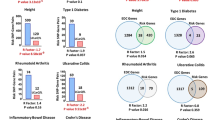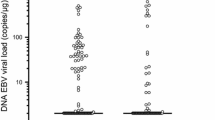Abstract
Despite extensive studies focusing on the changes in expression of microRNAs (miRNAs) in multiple sclerosis (MS) compared to healthy controls, few studies have evaluated the association of genetic variants of miRNAs with MS clinical course. We investigated whether a functional polymorphism in the MS associated miR-146a gene predicted clinical course (hazard of conversion to MS and of relapse, and annualized change in disability), using a longitudinal cohort study of persons with a first demyelinating event followed up to their 5-year review. We found the genotype (GC+CC) of rs2910164 predicted relapse compared with the GG genotype (HR=2.09 (95% CI 1.42, 3.06), p=0.0001), as well as a near-significant (p=0.07) association with MS conversion risk. Moreover, we found a significant additive interaction between rs2910164 and baseline anti-EBNA-1 IgG titers predicting risk of conversion to MS (relative excess risk due to interaction [RERI] 2.39, p=0.00002) and of relapse (RERI 1.20, p=0.006). Supporting these results, similar results were seen for the other EBV-correlated variables: anti-EBNA-2 IgG titers and past history of infectious mononucleosis. There was no association of rs2910164 genotype for disability progression. Our findings provide evidence for miR-146a and EBV infection in modulating MS clinical course.


Similar content being viewed by others
References
Baek D, Villen J, Shin C, Camargo FD, Gygi SP, Bartel DP (2008) The impact of microRNAs on protein output. Nature 455(7209):64–71. https://doi.org/10.1038/nature07242
Zhou Y, Simpson S Jr, Holloway AF, Charlesworth J, van der Mei I, Taylor BV (2014) The potential role of epigenetic modifications in the heritability of multiple sclerosis. Mult Scler 20(2):135–140. https://doi.org/10.1177/1352458514520911
Liu G, Abraham E (2013) MicroRNAs in immune response and macrophage polarization. Arterioscler Thromb Vasc Biol 33(2):170–177. https://doi.org/10.1161/ATVBAHA.112.300068
Junker A, Krumbholz M, Eisele S, Mohan H, Augstein F, Bittner R, Lassmann H, Wekerle H, Hohlfeld R, Meinl E (2009) MicroRNA profiling of multiple sclerosis lesions identifies modulators of the regulatory protein CD47. Brain 132(Pt 12):3342–3352. https://doi.org/10.1093/brain/awp300
Fenoglio C, Cantoni C, De Riz M, Ridolfi E, Cortini F, Serpente M, Villa C, Comi C, Monaco F, Mellesi L, Valzelli S, Bresolin N, Galimberti D, Scarpini E (2011) Expression and genetic analysis of miRNAs involved in CD4+ cell activation in patients with multiple sclerosis. Neurosci Lett 504(1):9–12. https://doi.org/10.1016/j.neulet.2011.08.021
Waschbisch A, Atiya M, Linker RA, Potapov S, Schwab S, Derfuss T (2011) Glatiramer acetate treatment normalizes deregulated microRNA expression in relapsing remitting multiple sclerosis. PLoS One 6(9):e24604. https://doi.org/10.1371/journal.pone.0024604
Godshalk SE, Bhaduri-McIntosh S, Slack FJ (2008) Epstein-Barr virus-mediated dysregulation of human microRNA expression. Cell Cycle 7(22):3595–3600
Vrijens K, Bollati V, Nawrot TS (2015) MicroRNAs as potential signatures of environmental exposure or effect: a systematic review. Environ Health Perspect. https://doi.org/10.1289/ehp.1408459
Ascherio A, Munger KL (2007) Environmental risk factors for multiple sclerosis. Part I: The role of infection. Ann Neurol 61(4):288–299. https://doi.org/10.1002/ana.21117
Ascherio A, Munger KL (2007) Environmental risk factors for multiple sclerosis. Part II: Noninfectious factors. Ann Neurol 61(6):504–513. https://doi.org/10.1002/ana.21141
Gong J, Tong Y, Zhang HM, Wang K, Hu T, Shan G, Sun J, Guo AY (2012) Genome-wide identification of SNPs in microRNA genes and the SNP effects on microRNA target binding and biogenesis. Hum Mutat 33(1):254–263. https://doi.org/10.1002/humu.21641
Lucas R, Ponsonby AL, Dear K, Taylor B, Dwyer T, McMichael A, Valery P, van der Mei A, Williams D, Pender M, Kilpatrick T, Chapman C, Coulthard A (2009) Associations between silicone skin cast score, cumulative sun exposure and other factors in the Ausimmune Study: a multicentre Australian study. Cancer Epidemiol Biomark Prev 18(11): 2887–2894
Strautins K, Tschochner M, James I, Choo L, Dunn DS, Pedrini M, Kermode A, Carroll W, Nolan D (2014) Combining HLA-DR risk alleles and anti-Epstein-Barr virus antibody profiles to stratify multiple sclerosis risk. Mult Scler 20(3):286–294. https://doi.org/10.1177/1352458513498829
Polman CH, Reingold SC, Edan G, Filippi M, Hartung HP, Kappos L, Lublin FD, Metz LM, McFarland HF, O'Connor PW, Sandberg-Wollheim M, Thompson AJ, Weinshenker BG, Wolinsky JS (2005) Diagnostic criteria for multiple sclerosis: 2005 revisions to the “McDonald criteria”. Ann Neurol 58(6):840–846
Kurtzke JF (1983) Rating neurologic impairment in multiple sclerosis: an expanded disability status scale (EDSS). Neurology 33(11):1444–1452
Prentice RL, Williams BJ, Peterson AV (1981) On the regression analysis of multivariate failure time data. Biometrika 68(2):373–379
Bashinskaya VV, Kulakova OG, Boyko AN, Favorov AV, Favorova OO (2015) A review of genome-wide association studies for multiple sclerosis: classical and hypothesis-driven approaches. Hum Genet 134(11–12):1143–1162. https://doi.org/10.1007/s00439-015-1601-2
Jazdzewski K, Murray EL, Franssila K, Jarzab B, Schoenberg DR, de la Chapelle A (2008) Common SNP in pre-miR-146a decreases mature miR expression and predisposes to papillary thyroid carcinoma. Proc Natl Acad Sci U S A 105(20):7269–7274. https://doi.org/10.1073/pnas.0802682105
Li Y, Du C, Wang W, Ma G, Cui L, Zhou H, Tao H, Yao L, Zhao B, Li K (2015) Genetic association of MiR-146a with multiple sclerosis susceptibility in the Chinese population. Cell Physiol Biochem 35(1):281–291. https://doi.org/10.1159/000369695
Khan D, Dai R, Karpuzoglu E, Ahmed SA (2010) Estrogen increases, whereas IL-27 and IFN-gamma decrease, splenocyte IL-17 production in WT mice. Eur J Immunol 40(9):2549–2556. https://doi.org/10.1002/eji.201040303
Dai R, Phillips RA, Zhang Y, Khan D, Crasta O, Ahmed SA (2008) Suppression of LPS-induced interferon-gamma and nitric oxide in splenic lymphocytes by select estrogen-regulated microRNAs: a novel mechanism of immune modulation. Blood 112(12):4591–4597. https://doi.org/10.1182/blood-2008-04-152488
Park R, Lee WJ, Ji JD (2016) Association between the three functional miR-146a single-nucleotide polymorphisms, rs2910164, rs57095329, and rs2431697, and autoimmune disease susceptibility: a meta-analysis. Autoimmunity:1–8. https://doi.org/10.3109/08916934.2016.1171854
Chan EK, Ceribelli A, Satoh M (2013) MicroRNA-146a in autoimmunity and innate immune responses. Ann Rheum Dis 72(Suppl 2):ii90–ii95. https://doi.org/10.1136/annrheumdis-2012-202203
Baumjohann D, Ansel KM (2013) MicroRNA-mediated regulation of T helper cell differentiation and plasticity. Nat Rev Immunol 13(9):666–678. https://doi.org/10.1038/nri3494
Pender MP, Burrows SR (2014) Epstein-Barr virus and multiple sclerosis: potential opportunities for immunotherapy. Clin Transl Immunology 3(10):e27. https://doi.org/10.1038/cti.2014.25
Zhou Y, Zhu G, Charlesworth JC, Simpson S Jr, Rubicz R, Goring HH, Patsopoulos NA, Laverty C, Wu F, Henders A, Ellis JJ, van der Mei I, Montgomery GW, Blangero J, Curran JE, Johnson MP, Martin NG, Nyholt DR, Taylor BV, consortium AN (2016) Genetic loci for Epstein-Barr virus nuclear antigen-1 are associated with risk of multiple sclerosis. Mult Scler. https://doi.org/10.1177/1352458515626598
Disanto G, Hall C, Lucas R, Ponsonby AL, Berlanga-Taylor AJ, Giovannoni G, Ramagopalan SV, Ausimmune Investigator G (2013) Assessing interactions between HLA-DRB1*15 and infectious mononucleosis on the risk of multiple sclerosis. Mult Scler 19(10):1355–1358. https://doi.org/10.1177/1352458513477231
Sundqvist E, Sundstrom P, Linden M, Hedstrom AK, Aloisi F, Hillert J, Kockum I, Alfredsson L, Olsson T (2012) Lack of replication of interaction between EBNA1 IgG and smoking in risk for multiple sclerosis. Neurology 79(13):1363–1368. https://doi.org/10.1212/WNL.0b013e31826c1ab7
Hedstrom AK, Bomfim IL, Barcellos LF, Briggs F, Schaefer C, Kockum I, Olsson T, Alfredsson L (2014) Interaction between passive smoking and two HLA genes with regard to multiple sclerosis risk. Int J Epidemiol 43(6):1791–1798. https://doi.org/10.1093/ije/dyu195
Acknowledgements
The members of the AUSLONG investigators group are as follows: Robyn M Lucas (National Centre for Epidemiology and Population Health, Canberra); Keith Dear (Duke Kunshan University, Kunshan, China); Anne-Louise Ponsonby and Terry Dwyer (Murdoch Children’s Research Institute, Melbourne, Australia); Ingrid van der Mei, Leigh Blizzard, Steve Simpson, Jr., and Bruce V Taylor (Menzies Institute for Medical Research, University of Tasmania, Hobart, Australia); Simon Broadley (School of Medicine, Griffith University, Gold Coast Campus, Australia); Trevor Kilpatrick (Centre for Neurosciences, Department of Anatomy and Neuroscience, University of Melbourne, Melbourne, Australia); David Williams and Jeanette Lechner-Scott (University of Newcastle, Newcastle, Australia); Cameron Shaw and Caron Chapman (Barwon Health, Geelong, Australia); Alan Coulthard (University of Queensland, Brisbane, Australia); and Patricia Valery (QIMR Berghofer Medical Research Institute, Brisbane, Australia).
Author information
Authors and Affiliations
Consortia
Corresponding author
Rights and permissions
About this article
Cite this article
Zhou, Y., Chen, M., Simpson, S. et al. Common genetic variation within miR-146a predicts disease onset and relapse in multiple sclerosis. Neurol Sci 39, 297–304 (2018). https://doi.org/10.1007/s10072-017-3177-1
Received:
Accepted:
Published:
Issue Date:
DOI: https://doi.org/10.1007/s10072-017-3177-1




